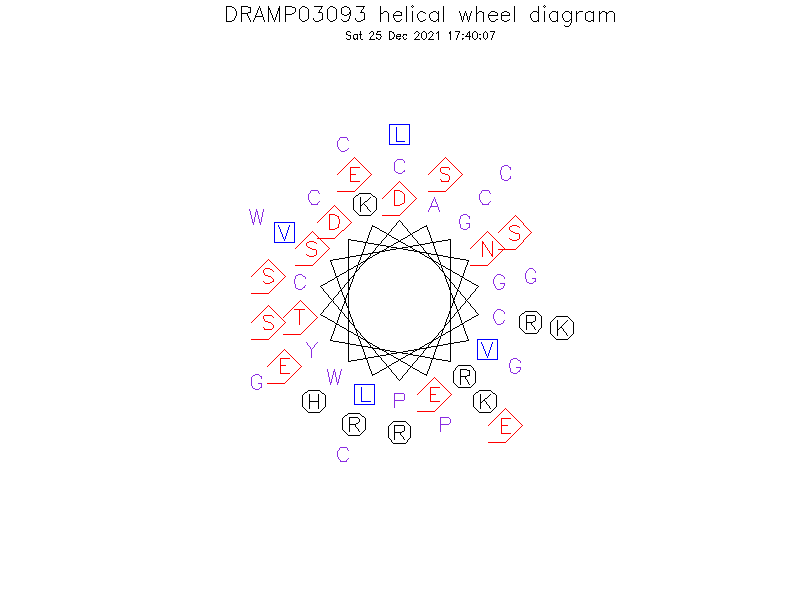General Information
Activity Information
-
Biological Activity
- Antimicrobial, Antifungal
-
Target Organism
-
- Fungi: Neurospora crassa (IC50=0.6 µM), Botrytis cinerea (IC50=1.2 µM), Fusarium culmorum (IC50=1.0 µM), Alternaria brassicicola (IC50=0.9 µM), A. longipes (IC50=1.4 µM), Nectria haematococca (IC50=1.8 µM), Fusarium oxysporum(IC50=4.2 µM), A. pisi (IC50=3.2 µM).
-
Hemolytic Activity
-
- No hemolysis information or data found in the reference(s) presented in this entry
-
Cytotoxicity
- No cytotoxicity information found in the reference(s) presented
-
Binding Target
- Not found
Structure Information
-
Linear/Cyclic
- Cyclic
-
N-terminal Modification
- Free
-
C-terminal Modification
- Cyclization (Cys2 and Cys44)
-
Nonterminal Modifications and Unusual Amino Acids
- Disulfide bonds between Cys2 and Cys44; Cys11 and Cys33; Cys19 and Cys39,Cys23 and Cys41.
-
Stereochemistry
- L
-
Structure
- Combine helix and strand structure
-
Structure Description
- Not found
-
Helical Wheel Diagram
-
PDB ID
- 1MYN resolved by NMR.
-
Predicted Structure
- There is no predicted structure for DRAMP03093.
Physicochemical Information
-
Formula
- C199H312N64O65S8
Absent Amino Acids
- FIMQ
Common Amino Acids
- C
Mass
- 4897.54
PI
- 7.7
Basic Residues
- 8
Acidic Residues
- 6
Hydrophobic Residues
- 7
Net Charge
- +2
-
Boman Index
- -112.69
Hydrophobicity
- -0.741
Aliphatic Index
- 33.18
Half Life
-
- Mammalian:1.1 hour
- Yeast:3 min
- E.coli:>10 hour
Extinction Coefficient Cystines
- 12990
Absorbance 280nm
- 302.09
Polar Residues
- 21
DRAMP03093

Comments Information
Function
- Possesses antifungal activity and is active against a relatively broad spectrum of filamentous fungi. It inhibits spore germination at high concentrations and at low concentrations delays growth of hyphae which subsequently exhibit abnormal morphology. Spz C-106 in the hemolymph controls expression of the antifungal peptide by acting as a ligand of Tl and inducing an intracellular signaling pathway.
Tissue specificity
- Synthesized in the fat body and is secreted into the blood. In hemolymph 6 hours after immune challenge, levels of expression increase for first 24 hours and persist for the following three weeks.
PTM
- Contains four disulfide bonds 2-44; 11-33; 19-39; 23-41.
Literature Information
- ·Literature 1
-
Title
- Insect immunity. Septic injury of drosophila induces the synthesis of a potent antifungal peptide with sequence homology to plant antifungal peptides.
-
Pubmed ID
- 7806546
-
Reference
- J Biol Chem 1994; 269: 33159-33163.
-
Author
- Fehlbaum P et al Hoffmann JA.
- ·Literature 2
-
Title
- The dorsoventral regulatory gene cassette spätzle/Toll/cactus controls the potent antifungal response in Drosophila adults.
-
Pubmed ID
- 8808632
-
Reference
- Cell. 1996 Sep 20;86(6):973-983.
-
Author
- Lemaitre B, Nicolas E, Michaut L, Reichhart JM, Hoffmann JA.
- ·Literature 3
-
Title
- Differential display of peptides induced during the immune response of Drosophila: a matrix-assisted laser desorption ionization time-of-flight mass spectrometry study.
-
Pubmed ID
- 9736738
-
Reference
- Proc Natl Acad Sci U S A. 1998 Sep 15;95(19):11342-11347.
-
Author
- Uttenweiler-Joseph S, Moniatte M, Lagueux M, Van Dorsselaer A, Hoffmann JA, Bulet P.
- ·Literature 4
-
Title
- Binding of the Drosophila cytokine Spätzle to Toll is
-
Pubmed ID
- 12872120
-
Reference
- Nat Immunol. 2003 Aug;4(8):794-800.
-
Author
- Weber AN, Tauszig-Delamasure S, Hoffmann JA, Lelièvre E, Gascan H, Ray KP, Morse MA, Imler JL, Gay NJ.

